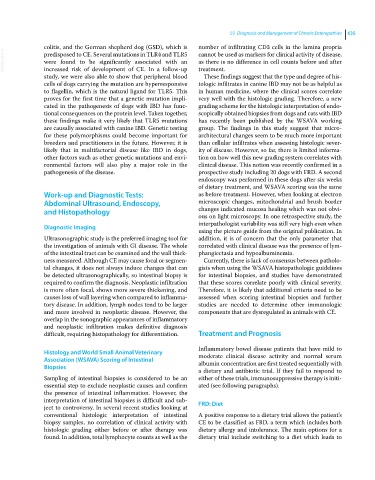Page 667 - Clinical Small Animal Internal Medicine
P. 667
59 Diagnosis and Management of Chronic Enteropathies 635
colitis, and the German shepherd dog (GSD), which is number of infiltrating CD3 cells in the lamina propria
VetBooks.ir predisposed to CE. Several mutations in TLR4 and TLR5 cannot be used as markers for clinical activity of disease,
as there is no difference in cell counts before and after
were found to be significantly associated with an
increased risk of development of CE. In a follow‐up
These findings suggest that the type and degree of his-
study, we were also able to show that peripheral blood treatment.
cells of dogs carrying the mutation are hyperresponsive tologic infiltrates in canine IBD may not be as helpful as
to flagellin, which is the natural ligand for TLR5. This in human medicine, where the clinical scores correlate
proves for the first time that a genetic mutation impli- very well with the histologic grading. Therefore, a new
cated in the pathogenesis of dogs with IBD has func- grading scheme for the histologic interpretation of endo-
tional consequences on the protein level. Taken together, scopically obtained biopsies from dogs and cats with IBD
these findings make it very likely that TLR5 mutations has recently been published by the WSAVA working
are causally associated with canine IBD. Genetic testing group. The findings in this study suggest that micro-
for these polymorphisms could become important for architectural changes seem to be much more important
breeders and practitioners in the future. However, it is than cellular infiltrates when assessing histologic sever-
likely that in multifactorial disease like IBD in dogs, ity of disease. However, so far, there is limited informa-
other factors such as other genetic mutations and envi- tion on how well this new grading system correlates with
ronmental factors will also play a major role in the clinical disease. This notion was recently confirmed in a
pathogenesis of the disease. prospective study including 20 dogs with FRD. A second
endoscopy was performed in these dogs after six weeks
of dietary treatment, and WSAVA scoring was the same
Work‐up and Diagnostic Tests: as before treatment. However, when looking at electron
Abdominal Ultrasound, Endoscopy, microscopic changes, mitochondrial and brush border
and Histopathology changes indicated mucosa healing which was not obvi-
ous on light microscopy. In one retrospective study, the
interpathologist variability was still very high even when
Diagnostic Imaging
using the picture guide from the original publication. In
Ultrasonographic study is the preferred imaging tool for addition, it is of concern that the only parameter that
the investigation of animals with GI disease. The whole correlated with clinical disease was the presence of lym-
of the intestinal tract can be examined and the wall thick- phangiectasia and hypoalbuminemia.
ness measured. Although CE may cause focal or segmen- Currently, there is lack of consensus between patholo-
tal changes, it does not always induce changes that can gists when using the WSAVA histopathologic guidelines
be detected ultrasonographically, so intestinal biopsy is for intestinal biopsies, and studies have demonstrated
required to confirm the diagnosis. Neoplastic infiltration that these scores correlate poorly with clinical severity.
is more often focal, shows more severe thickening, and Therefore, it is likely that additional criteria need to be
causes loss of wall layering when compared to inflamma- assessed when scoring intestinal biopsies and further
tory disease. In addition, lymph nodes tend to be larger studies are needed to determine other immunologic
and more involved in neoplastic disease. However, the components that are dysregulated in animals with CE.
overlap in the sonographic appearances of inflammatory
and neoplastic infiltration makes definitive diagnosis
difficult, requiring histopathology for differentiation. Treatment and Prognosis
Inflammatory bowel disease patients that have mild to
Histology and World Small Animal Veterinary moderate clinical disease activity and normal serum
Association (WSAVA) Scoring of Intestinal albumin concentration are first treated sequentially with
Biopsies
a dietary and antibiotic trial. If they fail to respond to
Sampling of intestinal biopsies is considered to be an either of these trials, immunosuppressive therapy is initi-
essential step to exclude neoplastic causes and confirm ated (see following paragraphs).
the presence of intestinal inflammation. However, the
interpretation of intestinal biopsies is difficult and sub- FRD: Diet
ject to controversy. In several recent studies looking at
conventional histologic interpretation of intestinal A positive response to a dietary trial allows the patient’s
biopsy samples, no correlation of clinical activity with CE to be classified as FRD, a term which includes both
histologic grading either before or after therapy was dietary allergy and intolerance. The main options for a
found. In addition, total lymphocyte counts as well as the dietary trial include switching to a diet which leads to

